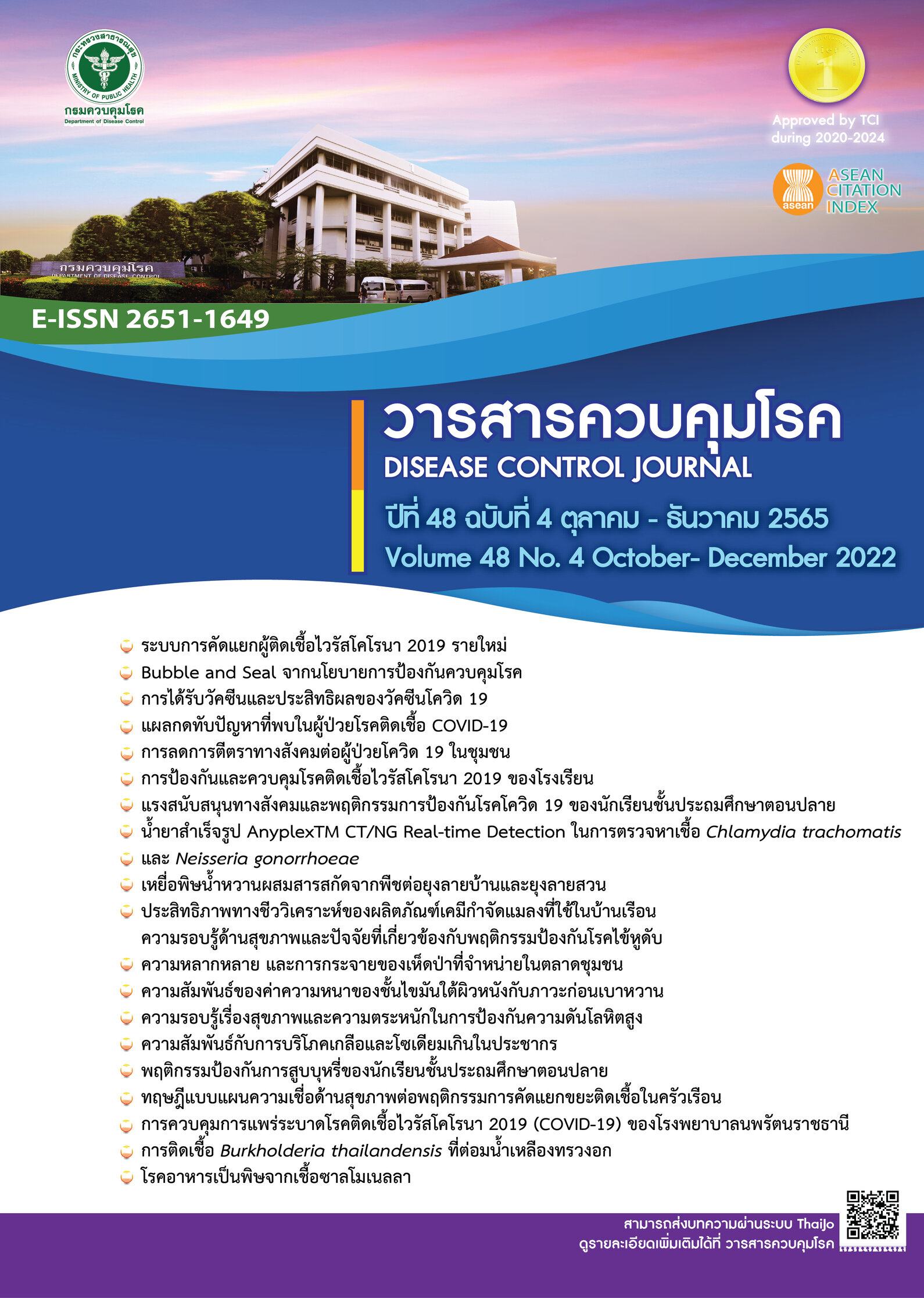The factors related to excess salt and sodium consumption among population in 4 provinces
DOI:
https://doi.org/10.14456/dcj.2022.74Keywords:
excess salt and sodium consumption, Thai population, 24-hour urinary sodium excretionAbstract
This cross-sectional study aimed to investigate factors related to excess salt and sodium consumption among population aged 20-69 years in four provinces: Phayao, Si Sa Ket, Ubon Ratchathani, and Amnat Charoen. The study was conducted from February to May 2021, two stages stratified cluster sampling was used to randomly select 360 samples in each province and weighted population was used to design weight with an adjustment by post-stratification. The research instruments composed of personal factors, health status, and health behavior questionnaire. The body weight, height, and blood pressure were measured, and 24-hour urine collection were conducted. Sodium intake level was estimated by 24-hour urinary sodium excretion. The data were analyzed by complex analysis, using weighted percentage, weighted means, odds ratio and 95% confidence interval. The findings revealed that weighted mean sodium consumption per day in 4 provinces was 3,236.8 mg with 75% of the total population consuming more than 2,000 mg of sodium. The factors that related to excess salt and sodium consumption among population statistically significant (p<0.05) were as follows: aged 20-29 years (adj. OR =2.33), overweight and obesity (adj. OR =2.03) and higher fruit and vegetable intake (adj. OR=1.75). The other variables were not statistically significant as female gender (adj.OR =1.31), living in urban area (adj. OR =1.21), high income (>10,000 Baht per month) (adj. OR =1.49), low estimated health score (adj. OR=1.36), higher education level (adj. OR=1.43), and less exercise (adj.OR=1.93). The Hypertensive state, buying food and cooking were not related to excess salt and sodium consumption. The results of this study should be considered for planning in promoting health literacy, providing policy-based population-approached interventions and providing social epidemiology surveillance to reduce salt and sodium consumption in Thai population.
Downloads
References
He FJ, MacGregor GA. Reducing population salt intake worldwide: from evidence to implementation. Prog Cardiovasc Dis. 2010;52(5):363-82. doi: 10.1016/j.pcad.2009.12.006.
O'Donnell M, Mente A, Rangarajan S, McQueen MB, Wang X, Liu L, et al. Urinary sodium and potassium excretion, mortality, and cardiovascular events. N Engl J Med. 2014;371:612-23. doi: 10.1056/NEJMoa1311889.
Aburto NJ, Ziolkovska A, Hooper L, Elliott P, Cappuccio FP, Meerpohl JJ. Effect of lower sodium intake on health: systematic review and meta-analyses. BMJ. 2013;346:f1326. doi: 10.1136/bmj.f1326.
World Health Organization. Guideline: Sodium intake for adults and children. Geneva: World Health Organization; 2012.
Mozaffarian D, Fahimi S, Singh GM, Micha R, Khatibzadeh S, Engell RE, et al.
Global sodium consumption and death from cardiovascular causes. N Engl J Med. 2014; 371:624-34. doi: 10.1056/NEJMoa1304127.
Apinya T. Report on the results of the review: Preventing non-communicable diseases in lifestyle by reducing salt intake. Bangkok: War Veterans Organization (WVO) Office of Printing Mill; 2013. (in Thai)
Chailimpamontree W, Kantachuvesiri S, Aekplakorn W, Lappichetpaiboon R, Thokanit NS, Vathesatogkit P, et al. Estimated dietary sodium intake in Thailand: A nationwide population survey with 24-hour urine collections. J Clin Hypertens. 2021;23(4):744-54. doi: 10.1111/jch.14147.
World Health Organization. Global action plan for noncommunicable diseases 2013-2020. Geneva: World Health Organization; 2013.
Xu J, Wang M, Chen Y, Zhen B, Li J, Luan W, et al. Estimation of salt intake by 24-hour urinary sodium excretion: a cross-sectional study in Yantai, China. BMC Public Health. 2014;14:136. https://doi.org/10.1186/1471-2458-14-136
World Health Organization. Measurement of Population Salt Intake in Salt Reduction Toolkit. [Internet] South-East Asia Region Office: World Health Organization; 2021 [cited 2022 June 8]. Available from: https://cdn.who.int/media/docs/default-source/searo/healthy-diets/salt-reduction/measurement-of-population-salt-intake.pdf?sfvrsn=b8e360f4_3
Aziz NSA, Ambak R, Othman F, He FJ, Yusof M, Paiwai F, et al. Risk factors related with high sodium intake among Malaysian adults: findings from the Malaysian community salt survey (MyCoSS) 2017–2018. J Health Popul Nutr. 2021;40(Suppl 1):14. doi: https://dx.doi.org/10.1186/s41043-021-00233-2
Hong JW, Noh JH, Kim DJ. Factors associated with high sodium intake based on estimated 24-hour urinary sodium excretion: The 2009–2011 Korea national health and nutrition examination survey. Medicine. 2016;95(9):e2864 doi:10.1097/MD.0000000000002864.
Thunthisirin K, Yamborisuth A. Nutrition and health in the elderly. JHealth. 1997;20(2):257-65. (in Thai)
National Statistical office. The 2021 Health Behavior of Population Survey [Internet]. Bangkok. National Statistical office; 2021. [cited 2022 Mar 13] 222 p. Available from: http://www.nso.go.th/sites/2014en/Lists/NewPublications/Attachments/183/THE2021.HBPS.pdf (in Thai)
Othman F, Ambak R, Man CS, Zaki NAM, Ahmad MH, Aziz NSA, et al. Factors associated with high sodium intake assessed from 24-hour urinary excretion and potential effect of energy intake. J Nutr Metab. 2019;2019:6781597.
Libuda L, Kersting M, Alexy U. Consumption of dietary salt measured by urinary sodium excretion and its association with body weight status in healthy children and adolescents. Public Health Nutr. 2012;15(3):433-41. doi:0.1017/S1368980011002138.
Ma Y, He FJ, MacGregor GA. High salt intake: independent risk factor for obesity. Hypertension. 2015;66(4):843-9.
Miyaki K, Song Y, Taneichi S, Tsutsumi A, Hashimoto H, Kawakami N, et al. Socioeconomic status is significantly associated with dietary salt intakes and blood pressure in Japanese workers (J-HOPE Study). Int J Environ Res Public Health 2013 Mar;10(3):980-93. doi: 10.3390/ijerph10030980.
Pechey R, Monsivais P. Socioeconomic inequalities in the healthiness of food choices: Exploring the contributions of food expenditures. Prev Med. 2016;88:203–9. doi: 10.1016/j.ypmed.2016.04.012.
Downloads
Published
How to Cite
Issue
Section
License
Copyright (c) 2022 Disease Control Journal

This work is licensed under a Creative Commons Attribution-NonCommercial-NoDerivatives 4.0 International License.
Articles published in the Disease Control Journal are considered as academic work, research or analysis of the personal opinion of the authors, not the opinion of the Thailand Department of Disease Control or editorial team. The authors must be responsible for their articles.






